

GEORGE LUCAS - HEROES, MYTHS & MAGIC - AMERICAN MASTERS 1993. The Mythology of Star Wars [FULL DOCUMENTARY] Star Wars Origins - Lightsabers. LEFT TOP: Universal Translator from Star Trek, The Original Series.
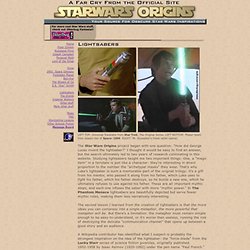
LEFT BOTTOM: Phaser beam from season two of Space: 1999. RIGHT: Mr. Skywalker's finest letter-opener. The Star Wars Origins project began with one question: "How did George Lucas invent the lightsaber? " I thought it would be easy to find an answer, but the search ultimately led to two years of research culminating in this website. The second lesson I learned from the creation of lightsabers is that the more ideas you can compress into a single metaphor, the more powerful that metaphor will be. Star Wars Origins - George Lucas' Personal Myth. Joseph Campbell often noted that while mythic structure is universal, myth itself must be kept fresh through reinterpretation.
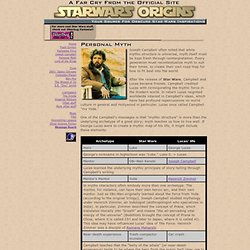
Every generation must recontextualize myth to suit their times, to create their own road map for how to fit best into the world. After the release of Star Wars, Campbell and Lucas became friends. Campbell credited Lucas with reinvigorating the mythic force in the modern world. In return Lucas reignited worldwide interest in Campbell's ideas, which have had profound repercussions on world culture in general and Hollywood in particular. Star Wars Origins - Joseph Campbell and the Hero's Journey. In 1949 Joseph Campbell (1904-1987) made a big splash in the field of mythology with his book The Hero With a Thousand Faces.
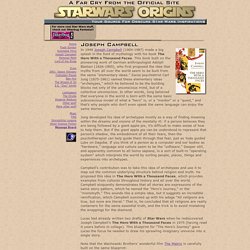
This book built on the pioneering work of German anthropologist Adolph Bastian (1826-1905), who first proposed the idea that myths from all over the world seem to be built from the same "elementary ideas. " Swiss psychiatrist Carl Jung (1875-1961) named these elementary ideas "archetypes," which he believed to be the building blocks not only of the unconscious mind, but of a collective unconscious. Star Wars Origins - Akira Kurosawa. Star Wars Origins - Flash Gordon. George Lucas has often said that his original idea for the project that evolved into Star Wars was to remake the Flash Gordon movie serials from the 1930s (a "serial" is a movie shown in weekly installments of about 10-20 minutes each).
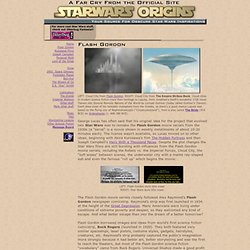
Star Wars Origins: How did George Lucas create Star Wars? The Hero's Quest. |Arthurian Legend| |Beowulf| |Classical Mythology| |Creation Stories| |Fairy Tales and Folktales| |Homer, The Iliad and The Odyssey| |Mythology Main Page| The all-purpose guide to epic moviesThis chart shows different archetypal roles at work in Harry Potter, Star Wars, and other movies: the hero, the threshold guardian, the trickster, etc.

An Anti-Hero of One's OwnThis TED-ED video (4:11) explores the pattern of the anti-hero using references to Fahrenheit 451 and 1984, among others. Captioned, includes follow-up questions and other support. ArchetypesThis Google Doc lists and describes types of heroes, quests, stages, characteristics, and symbols. Students are invited to find examples. Mythology in Star Wars. Nobody paid $7 to hear Homer read The Odyssey, or lined up to buy Thomas Malory's 15th-century version of King Arthur's legend.

But, when Star Wars Episode 1: The Phantom Menace opens at 12:01 a.m. Wednesday, George Lucas' epic of galactic good and evil will be seen by more people in one day than Homer or Malory ever dreamed of reaching in their lifetimes. Different eras, different heroes, yet Lucas' film series contains the same mythic qualities those ancient storytellers and others used to fuel imaginations throughout the ages. The Hero's Journey: Life's Great Adventure. Star Wars Origins - Joseph Campbell and the Hero's Journey. Star Wars. Star Wars is a science fiction franchise comprised of movies, books, comics, video games, toys, and animated shows.

It is a fictional universe created by George Lucas. The Star Wars story employs archetypal motifs common to science fiction, political climax and classical mythology, as well as musical motifs of those aspects. Overview "George Lucas has achieved what few artists do; he has created and populated a world of his own. His 'Star Wars' movies are among the most influential, both technically and commercially, ever made. " ―Ebert & Roeper[src] The Star Wars story has been presented in a series of American films, which have spawned a large quantity of books and other media, which have formed the Expanded Universe.
Hero's Journey Foundation - life-altering adventures for men and women - HerosJourneyFoundation.org. Hero's journey. "A Practical Guide to Joseph Cambell’s The Hero with a Thousand Faces" by Christopher Vogler © 1985 “There are only two or three human stories, and they go on repeating themselves as fiercely as if they had never happened before.”
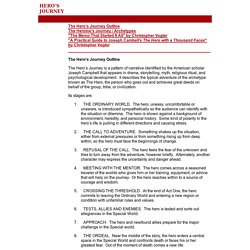
HeroJourneyStarWars.pdf (application/pdf Object) Star Wars: The Hero's Journey - Part 1. Joseph Campbell, Star Wars, and the Hero's Journey. Christopher Vogler's "Hero's Journey" (Revised July 2007) I spent nearly sixteen years avoiding reading anything of substance by (Hollywood) story theorists such as Syd Field, John Truby, Christopher Vogler, Robert McKee and others.
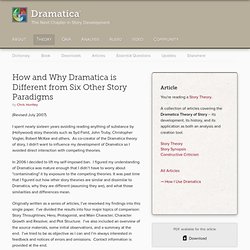
As co-creator of the Dramatica theory of story, I didn't want to influence my development of Dramatica so I avoided direct interaction with competing theories. In 2006 I decided to lift my self-imposed ban. I figured my understanding of Dramatica was mature enough that I didn’t have to worry about "contaminating" it by exposure to the competing theories. It was past time that I figured out how other story theories are similar and dissimilar to Dramatica, why they are different (assuming they are), and what those similarities and differences mean. Originally written as a series of articles, I’ve reworked my findings into this single paper.
There are dozens of “how to” books on story structure, especially in the screenwriting field. SYD FIELD: I watched Syd Field's video, "Screenwriting Workshop. " Beowulf and Star Wars. BEOWULF AND STAR WARS with references to Episode III and Jung THE FOREMOST MYTHOLOGIST OF OUR DAY, JOSEPH CAMPBELL wrote a book called The Hero With a Thousand Faces, in which he noted that whatever the name or face: Achilles, Odysseus, Telemachus, Oedipus, Beowulf, Capts.
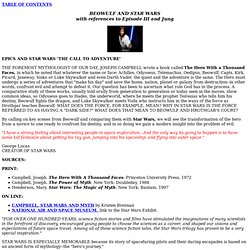
Kirk, Picard, Janeway, Sisko or Luke Skywalker and even Darth Vader, the quest and the adventure is the same. The Hero must undergo a series of adventures that "make his day" and save the home, nation, planet or galaxy from destruction--in other words, confront evil and attempt to defeat it. Our question has been to ascertain what role God has in the process. Hero's Journey. The hero's journey is an ancient story pattern that can be found in texts from thousands of years ago or in newly released Hollywood blockbusters. This interactive tool will provide students with background on the hero's journey and give them a chance to explore several of the journey's key elements. Students can use the tool to record examples from a hero's journey they have read or viewed or to plan out a hero's journey of their own. Grades 6 – 8 | Lesson Plan | Standard Lesson Fantastic Characters: Analyzing and Creating Superheroes and Villains Students analyze characterization by creating their own superheroes or super-villains, complete with related gadgets and settings.
Grades 7 – 12 | Calendar Activity | July 31 J.K. Students are encouraged to think about why people challenge Harry Potter books, do a Web Quest that allows them to research the issue, and decide whether the books should be banned from the public library. Grades 7 – 12 | Calendar Activity | January 3. The Hero with a Thousand Faces.
The Hero with a Thousand Faces (first published in 1949) is a work of comparative mythology by Joseph Campbell. In this book, Campbell discusses his theory of the mythological structure of the journey of the archetypal hero found in world myths. Since the publication of The Hero with a Thousand Faces, Campbell's theory has been consciously applied by a wide variety of modern writers and artists. Filmmaker George Lucas acknowledged Campbell's theory in mythology, and its influence on the Star Wars films.[1] Summary[edit] Campbell explores the theory that mythological narratives frequently share a fundamental structure.
A hero ventures forth from the world of common day into a region of supernatural wonder: fabulous forces are there encountered and a decisive victory is won: the hero comes back from this mysterious adventure with the power to bestow boons on his fellow man.[3] In laying out the monomyth, Campbell describes a number of stages or steps along this journey. Background[edit]